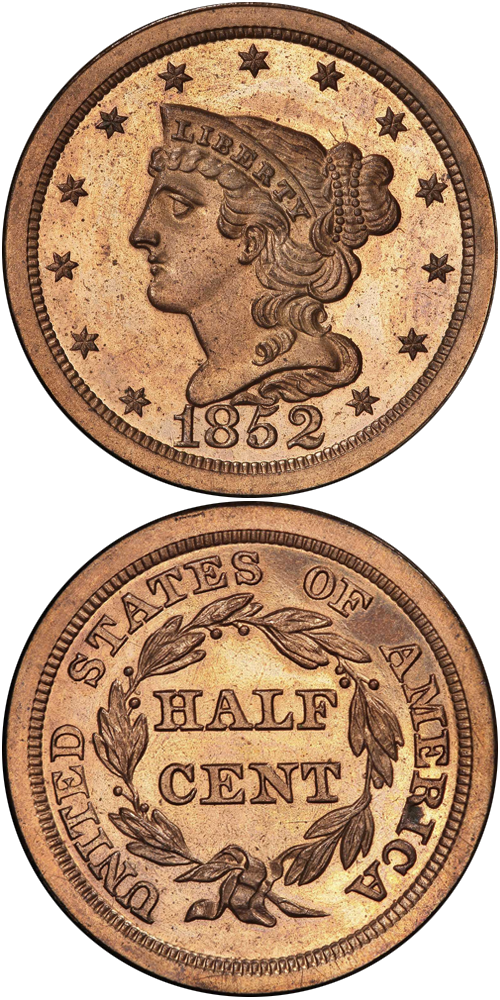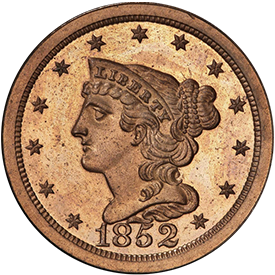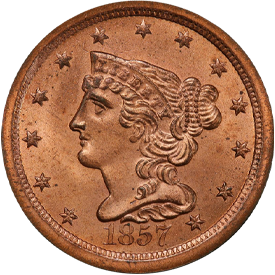Designed by: Christian Gobrecht
Issue Dates: 1840-1857
Composition: Copper
Diameter: 23 mm
Weight: 5.44 grams (84 grains)
Edge: Plain
Business Strike Mintage: 544,510
Proof Mintage: Fewer than 1,500, combined originals and restrikes
In 1840 a new half cent design, the Braided Hair style, made its appearance. However, there was not a demand for new pieces in the channels of commerce, for the Treasury had vast stores of undistributed earlier coins upon which it could draw, so no new half cents were struck for circulation until 1849.
Specimens of the 1840-1848 years were limited to Proofs made for collectors. The obverse design depicts a trim head of Miss Liberty facing left, her hair in a bun tied with two beaded cords, and with the word LIBERTY on a diadem or coronet. Tresses hang downward to her neck. Surrounding the obverse border are 13 stars and the date. The reverse design is somewhat similar to the style used on half cents of the 1809-1836 era and consists of a continuous wreath tied with a ribbon below, enclosing HALF CENT, with UNITED STATES OF AMERICA around the border, although the details are slightly different from those used earlier.
Half cents were produced in quantities for circulation from 1849 through 1851 and again from 1853 through 1857. In the latter year the denomination was discontinued. As half cents did not circulate extensively, particularly during the era of the Braided Hair design, specimens surviving today are apt to be in higher grades from Fine through Very Fine. Extremely Fine and AU coins are encountered with some frequency. Uncirculated pieces are scarce, and truly superb Uncirculated coins are very scarce.
Further Reading
The coinage of regular issue half cents resumed with issues beginning in 1840. Those dated 1840 through 1848 are known only in Proof condition. No business strikes were produced for general circulation. The Proofs of this era are all extremely rare, and no more than 75 or so are known of even the most "common" varieties. In fact, fewer than a dozen are known of a number of pieces. The obverse style is the so-called Braided Hair type first used on large cents in 1839, and represents the last major design in the half cent series.
Of the issues from 1840 through 1848, plus the Small Date variety of 1849, three main varieties can be collected for each year.
The so-called "originals" are distinguished by the large berries that appear in the reverse wreath. It is believed that most (but not all) large-berries half cents of the 1840-1849 years were produced during the dates indicated, but the same reverse was also employed for certain restrikes (which can be characterized by having bulged dies, unnaturally high "wire" rims, and other features). The second variety, called the "first restrike," has small berries and the N and T in CENT and portions of the wreath ribbon are recut.
The so-called "second restrike" pieces also have small berries but lack the recutting features of the "first restrike" pieces. Above the letters RICA in AMERICA are parallel diagonal die striations extending from the denticles in the border.
Regular coinage of half cents for circulation commenced in 1849. In that year the pieces made for business purposes had larger numerals in the date than did the Proof issues. Close to 40,000 pieces were struck in 1849, a number approximating the quantity made the following year, 1850. Pieces are frequently encountered in grades from Fine to AU. Uncirculated coins displaying original mint red are rarities. 1850 half cents are seen with about the same frequency as 1849 large date issues, except that Uncirculated pieces with mint red occasionally appear.
Half cents of the year 1851, minted to the extent of 147,672 pieces, were struck from a single pair of dies. The obverse depicts a small blunder when viewed under magnification. Traces of an earlier numeral 1 can be seen to the right of the final 1 of the date. This issue is the most plentiful of all Braided Hair half cents. Examples are usually seen in grades from Very Fine through AU, but Uncirculated pieces, even with mint red, appear from time to time.
No coinage for circulation was accomplished in 1852. All known specimens are Proofs, divided into issues with small berries and large berries. Several hundred examples are known, most with the small berries format.
In 1853 half cents were again struck for circulation. Although the mintage for this date is relatively high for the period (nearly 130,000 pieces), the 1853 is apparently unknown in full brilliant Uncirculated grade with original surface coloration. Most Mint State examples have varying degrees of brown coloration. From 1853 through the end of the series in 1857, half cents usually are found in conditions from Very Fine upward. Well-worn specimens are seldom seen.
The years 1854 through 1857 saw additional half cent production. Most examples encountered grade from Very Fine to AU, but Uncirculated pieces are not rare. Certain Mint State examples of 1854 and 1855 in particular are believed to have come from Charles French, who for many years conducted a coin and hobby business in Troy, New York. It has been said that at one time he purchased a "pig in a poke," an unopened safe. Upon examination, the contents yielded 500 sparkling half cents. Most of these had the inevitable "flyspecks," or tiny carbon spots. Such flyspecks are nearly always seen on Uncirculated half cents unless pieces have been cleaned.
In February 1857 the half cent denomination was discontinued, thus ending one of the most curious denominations in United States coinage history.








